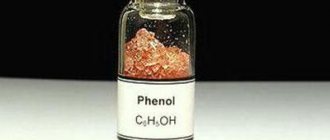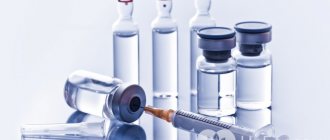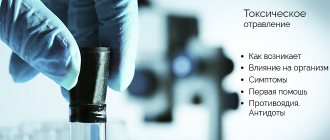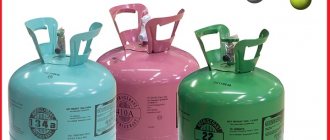Once upon a time there lived such a scientist - Philip Theophrastus von Hohenheim, better known as Paracelsus. He believed that all substances in the world are poisons, the only question is the dose. To some extent, he was right. Intoxication of the body can be caused by anything, and it is not necessary to consider something with a skull icon on it to be poison. Everything that can poison you is sold in wine and grocery stores, pharmacies and departments of manufactured goods.
What is chemical poisoning and its features
There are acute and chronic poisoning by chemicals. The following can act as poison:
- Medications.
- Pesticides.
- Household and auto chemical goods.
- Solvents.
- Reagents used in laboratories.
- Chemical elements used in production.
Toxins can enter the body through the respiratory tract or digestive tract. Cases of penetration of poisons through the skin or mucous membranes have been observed. Poisoning can be caused by an anthropogenic factor.
Adults are exposed to poisoning due to non-compliance with safety rules or in the event of industrial accidents. Children become victims of exposure to chemicals due to the negligence of adults.
ICD 10 code – X40-X49 (accidental poisoning with toxic substances), T36-T50 (poisoning with drugs and biological substances).
What's dangerous about this poison?
- Cadaverina. A colorless liquid resulting from the decomposition of proteins. In small doses, cadaverine does not pose a threat to life; a dose of 2 thousand milligrams is considered fatal. The substance dissolves in alcohol and water, and gastric juice copes well with it. As a chemical element, cadaverine is involved in a variety of biological processes.
- Neirina. An extremely toxic substance formed as a result of the decomposition of nerve cells and endings. Poisoning also requires a fairly large dose, which is simply impossible to obtain from one corpse, which allows us to say that contact with one dead person can be considered completely safe. It is neurin that is most often called cadaveric poison.
- Putrescina. A dangerous toxic substance that is a product of the decomposition of meat and fish in the large intestine.
The listed substances are called cadaveric poison.
In itself, one decomposing corpse is not dangerous; the sweetish smell emanating from it can cause a feeling of nausea, dizziness, and vomiting, which will not have serious consequences for the body of a healthy person.
At the same time, being surrounded by decaying corpses for a long time is dangerous. It was the large number of improperly buried dead that was the reason for the invariably recurring plague epidemics in the Middle Ages and subsequent research into the dangers of cadaveric poison.
Signs and symptoms of toxic chemical poisoning
Manifestations of intoxication with chemical substances depend on the type of poison, quantity and duration of entry into the body.
The main signs of mild intoxication are:
- weakness, apathy;
- pale skin;
- stomach ache;
- nausea;
- vomit;
- diarrhea;
- chills;
- dizziness;
- cough (if chemicals enter the respiratory tract).
In case of severe intoxication, note:
- Redness, bluishness of the skin.
- Vomit.
- Increased salivation.
- Fainting.
- Problems with consciousness.
- Anemia.
- Cramps.
- Heartbeat disorders.
- Difficulty breathing.
- Change in color of the mucous membrane.
- Headache.
- Aches in the joints.
- Oliguria.
- Hyperthermic syndrome (increase in temperature is observed with toxic damage to the brain).
- Coma.
Upon contact of the reagent with skin, the following may occur:
- focal redness of the skin;
- rashes;
- the appearance of burn blisters;
- pain and burning at the point of contact;
- tachycardia;
- dyspnea.
Signs of chemical poisoning are a reason to immediately seek qualified medical help. Losing time is fraught with the development of complications and irreversible pathological processes. With severe intoxication and lack of therapeutic measures, the victim may die.
The leading cause of death is carbon monoxide poisoning. The peculiarity of the substance is that it is odorless and colorless and has a rapid effect on humans.
Types of toxins
Poisons are divided into certain groups. They are divided according to the purpose of use, the effect on the body, and other characteristics. According to the purposes of application, there are:
- household,
- industrial,
- pharmacological,
- chemicals for the agricultural industry,
- toxic weapon,
- biological toxins.
According to the damage to certain organs, there are poisons, for example, of the nephrotoxic order, that is, those that negatively affect the kidneys. These include chlorine, heavy metals, mercury, ethyl alcohol. There are components that mainly affect the brain, that is, substances with neurotoxic effects. They are found in carbon monoxide, drugs, alcohol, sedatives, antidepressants, and other products.
Gastroenterotoxic substances usually have a negative effect on the gastrointestinal tract. These are acids, alkalis, and salts of heavy metals. The liver is affected by hepatotoxic toxins. These include phenol, aldehydes, and dangerous chlorinated hydrocarbons. Representatives of hepatotoxins are poisonous mushrooms, in particular fly agaric and toadstool.
Overdose of Ergoferon
Aniline and nitrites are included in the group of hematotoxic substances. They destroy red blood cells. Cardiotonic components have a pathological effect on the cardiovascular system. An overdose of barium, cardiac glycosides, and potassium salts can lead to severe poisoning.
For example, lily of the valley, cherry, and aconite have cardiotonic properties. Dangerous poison - tetradotoxin - is contained in blue-ringed octopuses, ray-finned fish, and pufferfish.
First aid rules
Competent provision of emergency first aid is an important stage in saving a victim from the influence of chemicals, fumes of toxic substances, and gas.
- If poison enters the digestive tract, the stomach should be rinsed immediately, allowing the victim to drink a lot of warm water and induce vomiting. It is recommended to carry out the procedure several times. If intoxication is caused by ingestion of an alkali or acid, gastric lavage cannot be done to avoid intensifying the reaction. They give you lime water, milk, sunflower oil, and egg whites to drink.
- In case of poisoning through inhalation of vapors or gas, it is necessary to remove or remove the person to fresh air. To avoid poisoning yourself, you need to cover your nose and mouth with clothing. The victim needs to unbutton his collar, free his neck from his tie, scarf, handkerchief and give him a drink of water. An unconscious person should be laid down and their head turned to the side in case they vomit.
- In case of food poisoning or ingestion of poison, cleansing enemas are given. For them, boiled warm water is used, with a temperature not exceeding 37 C. These actions reduce the absorption of toxins in the intestinal walls.
- Taking sorbents is necessary to absorb toxic substances. But sorbents are not antidotes - they eliminate those toxins that have not had time to be absorbed into the blood. They should be taken immediately after the first symptoms appear and call an ambulance. It is important to follow the dosage: 1 tablet of activated carbon is designed for 10 kg of human weight. It will not be possible to cleanse the body with a smaller dose.
- If the reagent comes into contact with the skin, the damaged area must be thoroughly rinsed with water.
Intoxication with pesticides occurs due to violation of instructions for the use and storage of chemicals. First aid for exposure to organophosphorus compounds:
- if the poison penetrates the respiratory tract, the patient should be given 2 tablets of belladonna (extract of the belladonna herb) or 8 drops of atropine 0.1%;
- if poison enters the gastrointestinal tract, the victim needs to drink 1 liter of water with 7-10 tablets of activated carbon dissolved in it and induce vomiting;
- if breathing stops, perform artificial respiration;
- give a laxative (solution of magnesium sulfate or Carlsbad salt);
- transport the poisoned person to the hospital.
How to protect yourself from corpse poison?
Protecting yourself from the effects of cadaveric poison is quite simple. In ordinary life, a person is unlikely to need to take any security measures, but when visiting a morgue, or a place where a deceased person has been lying for a long time, it is necessary:
- put on rubber gloves and a mask,
- check that all areas of the body are securely covered with fabric,
- If there are puncture wounds on the body, then direct contact with the decomposing corpse is best avoided.
The rooms where the deceased lay are ventilated, the floor, table, chairs and even walls are treated with water and bleach. The rag used for this is thrown away. If the room still smells like a corpse, it can be treated with an ultraviolet emitter. The poison will not harm physically healthy people, causing only mild poisoning with cadaveric poison, but for patients with a weakened immune system, it is better not to approach the dead, even to say goodbye before closing the coffin.
The poison can enter the body with food, so doctors do not recommend eating rotten or rotting meat, even if this threatens starvation. A person who eats rot will not live long in any case, for which there is a lot of evidence.
What medications to take for chemical poisoning
After first aid, treatment of chemical poisoning is carried out in a hospital. To carry out therapeutic measures, the patient's condition is assessed. If the chemical agent is known, the doctor may prescribe an antidote. In case of an overdose of narcotic opium alkaloids, Naloxone is prescribed. But not all poisons have antidotes; therapy is aimed at:
- Stopping the absorption of toxins into the body.
- Removing toxic substances absorbed by sorbents from the body.
- Elimination of symptoms of poisoning (restoration of the function of affected systems or organs).
If there is no vomiting to empty the stomach, the patient is given Ipecac syrup. The medicine can be given to a child and an adult to drink (15-30 ml), but simultaneous use with sorbents should be avoided. If there is no vomiting, a repeat dose of the drug should be taken after 20-30 minutes.
In a hospital setting, an intramuscular injection of Apomorphine may be prescribed, which induces vomiting within 5 minutes.
For the adsorption of poisons, the following are prescribed: Activated carbon: black and white, Carbolong, Smecta, Enterosgel, Polysorb MP, Polyphepan, Filtrum-STI. To remove adsorbed toxins from the body, laxatives are used: Magnesia, Sodium Sulfate. If there are seizures, the patient is administered intravenously Phenytoin, Diazepam, Phenobarbital.
In case of intoxication after chemotherapy, which is accompanied by vomiting, drugs are used to relieve unpleasant urges. The above sorbents are used.
Important Notes
In case of an alcohol overdose, the main thing is to pour as much liquid into the victim as possible, from 2 liters parenterally and from 3 liters orally. B vitamins are added to the dropper solution.- If symptoms of poisoning are observed regularly, small doses of the prescribed medication make you feel ill and a change in the drug is required.
- A syringe with the drug Athens in the first aid kit is for quick administration in case of poisoning with organophosphorus poisons, when the absence of this drug can cost life, and not for just use or sale.
- If a child is poisoned, a doctor should treat it. In children, symptoms may appear atypical or, conversely, extensively.
One way or another, at the first signs of poisoning, witnesses to what is happening only need to call an ambulance and provide first aid on the spot. Everything else is the concern of specialists.
Possible complications
The consequences of exposure to toxins can be complications:
- Edema of the lungs, brain, larynx.
- Decreased central nervous system functions.
- Hypotension (severe decrease in blood pressure).
- Cardiac arrhythmia.
- Tissue hypoxia.
- Acute form of renal or liver failure.
- Violation of the water-electrolyte balance of the blood.
Poisoning with chemical substances is characterized as a dangerous condition for the victim and ignored symptoms can lead to disability. It is necessary to provide first aid in time, call a doctor and begin to treat intoxication.
The article was approved by the editors
Infection with cadaveric poison
It is quite difficult to become infected with cadaveric poison in modern conditions. In the Middle Ages, infection with cadaveric poisons occurred faster and more often. So, archers often applied poison to their arrows, extracting the liquid from a dead body, they soaked the arrows in it and sent them at the enemy. A person wounded by such an arrow died in terrible agony within 1-2 days. The wound site swelled and began to fester; the result of poisoning was general blood poisoning and subsequent death. If handled carelessly with arrows, the archer himself could die. For this, only a small wound on the body, left by any sharp object, was enough.
The poison affects the body through cracks, bites, and small puncture wounds. It is impossible to become infected with cadaveric poison through a large wound, just as it is impossible to die from the fact that a small amount of poison got into a body of water, and subsequently into the stomach. As mentioned above, the only danger is a large amount of cadaveric poison. The body copes with small doses on its own.
And yet, in ancient times they believed that it was the entry of a decomposing corpse of an animal or a person into a reservoir that caused the death of livestock and the death of people. In most cases, the cause of death was cholera, the bacterium that causes botulism, or any other infection caused by decay processes.
In the Middle Ages, corpses in the river scared away enemies, forcing them to move to a new place in search of clean water. In fact, the current quickly carried away all the pathogenic bacteria, and the only danger was the place where the body was found. Superstitious people who do not understand poisons did not understand this.
If we are talking about closed reservoirs - wells, lakes, ponds. Having discovered the corpse of an animal in such a reservoir, modern epidemiologists disinfect the water and prohibit it from being consumed unless it has been boiled.
It is impossible to become infected after contact with a pathologist; the poison is not airborne or transmitted through mucous membranes.
Video on the topic
To summarize all of the above, watch the video, which describes the features of cadaveric poison, as well as several other interesting facts:
Poisoning of the body can be caused by various substances and methods. Industrial and domestic, accidental and intentional, criminal and suicidal - all this refers to health damage caused by intoxication. No matter how the toxins enter the body, they can disrupt its functioning, cause serious consequences, and sometimes lead to death.
Prevention
It is difficult for a city person to avoid contact with heavy metals and chemicals. They enter our lungs with car exhaust gases. Penetrates into the stomach along with tap water. You can always limit their intake by following certain rules:
- drink bottled water;
- go out of town for the weekend;
- do not use antiperspirants, deodorants;
- Do not cook food in aluminum foil;
- replace amalgam fillings.
By following these rules, you will limit the accumulation of harmful substances in the body and maintain health.
Before using any household chemicals at home, study their composition. They may contain dangerous caustic soda and liquid glass. Keep medications and cleaning agents out of the reach of children.
Diagnostics
To find out the source of poisoning and make an accurate diagnosis, the patient is prescribed to undergo a series of tests.
- The clinical picture is being clarified. The doctor performs an examination and survey, which makes it possible to determine the type of intoxication as much as possible based on the first signs.
- Instrumental research. Using a cardiogram, the condition of the heart is determined, and an encephalogram shows brain activity. To determine the degree of damage to internal organs of ultrasound organizations.
- Lab tests. The quantitative and qualitative presence of toxic substances in the body is determined, as well as the severity of the effects of poisons on the kidneys, liver, intestines and other vital organs.
An integrated approach to the diagnosis of poisoning allows not only to identify toxic substances, but also to determine the degree of damage to the body.
Cardiogram shows the condition of the heart











